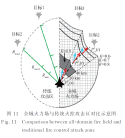There aint any actual numbers so it could very well be tracking range for a simulated LO target from different vectors. Also there is a RCS plot right next to this graph.
If tracking distance was the focus then they would compare radar models not AAM models. And the sides would have the longest ranges.
That depends on whether the graph depicts a moving target.
It almost certainly does. I would say it depicts something really high performing. The graph looks like a target-centric employment graph, as also noted by others. The PL-12 was depicted to have an almost zero effective range in chase against what was assumed.
The massive uplift by the PL-15 over PL-12 in that aspect is very notable and supports this position too. In a head-on engagement it has a 200% range improvement. In a tail-aspect engagement the difference is about 600%. The PL-15 is a significantly faster missile with a better speed retention and a dual-pulse motor. The latter improves the average speed in medium range shots by limiting the top speed (hence losses to the air resistance which scale quadratically with the speed).
This said ability to sustain high speeds is very important for tail-aspect shots because the missile has to stay above the speed of the aircraft to get closer. Head-on, a Mach 2 missile is still useful against the F-15. From behind, it is not. The aircraft can just outrun that, hence the range of the missile collapses to the range it can stay significantly above Mach 2.
By the Gods, the Cry Hinds are already capitalising on this info for more cope.
I don't think most of the Indian defense commentators know AAM ranges are context specific. I have been reading defense content for almost 20 years. I think I saw less than 10 Indian media articles that I found good. Most of their discussion space is nationalism washed bragging and simplifications.

